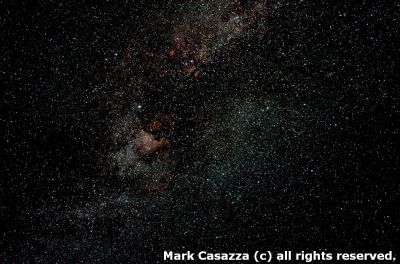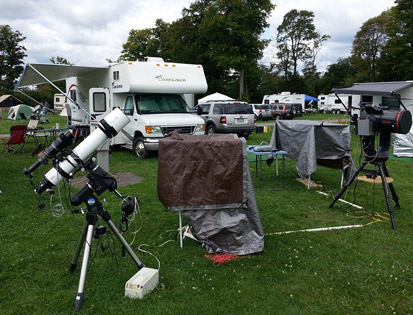My passion to see distant, dim objects led to many challenges. One being to find Pluto in a star field of about 50 stars. Pluto looks exactly like a star, just a dim point of light. When I first set my mind to find it I commanded my telescope to go to Pluto and it did, but when I looked in the eyepiece, I did not find 6 or 7 stars. I was greeted with an eyepiece full of stars. Which one was Pluto? My trusty computer showed me the same view I should see in my eyepiece, but these views are never the same. While the telescope gets close to the right spot, it can miss by as much as a full width of the eyepiece view. It took well over 30 minutes looking in the eyepiece, then the computer, then back before I found the pattern and found Pluto. At the time Pluto was still a planet and that checked off my see-every-planet challenge.
My next goal was to find the most distant object I might ever see: a quasar by the name 3C273. Quasars are galaxies with very active central black holes. That is, they are engorging themselves with material falling into their black hole. This material gets very hot, glows, and shoots out in jets perpendicular to the plain of the galaxy. 3C273 is the brightest of the quasars and is estimated to be 2.443 billion light years away! Light travels fast; 186,000 miles-per-second fast. But space is huge. The light I saw from 3C273 had been traveling for over 2 billion years before it reached my eye. When that quasar first came to be, Cyanobacteria just invented photosynthesis and started to make oxygen here on Earth. The universe is amazing.
There are many billions of galaxies and other interesting objects that are farther away than Pluto and closer than 3C273, and I enjoy finding them all. Some of these objects just refuse to be seen with my aging eyes. One great example is the North American Nebula. This object is very large in the sky with a very low surface brightness and is mostly red in color. Our eyes are least sensitive to red light which makes this object hard to see. Despite an 11” mirror on my telescope and a very dark observing location I could never see it. I even looked with my friends’ larger telescopes and could not see it. I knew with a camera I would be able to easily photograph it. And so began my next quest: become an astro-photographer.
 I had already tried a few unsuccessful ventures into astrophotography with my 11” telescope. I figured out that the length of my telescope was producing so much magnification that if I didn’t have the absolute perfect conditions, my results would be bad images. So in June of 2011 I put an old Olympus zoom lens on a modified Canon T1i camera, and then attached both of these to a mount. The camera was modified by replacing the infrared and anti-aliasing filters with clear glass. This would allow it to “see” infrared light, as well as normal and ultraviolet light. The mount would allow a camera or telescope to track the stars as the move through the sky with only one motor running. This is essential for long exposures. I set the camera to ISO 1600, pointed it in the right direction, focused the viewfinder and took 40-second pictures. I took 30 pictures that first night, and I could see the North American Nebula in each one! The next day I used special software to combine all 30 images into 1 single better image, and I have my very first astrophoto. It was not great, but it was worth keeping!
I had already tried a few unsuccessful ventures into astrophotography with my 11” telescope. I figured out that the length of my telescope was producing so much magnification that if I didn’t have the absolute perfect conditions, my results would be bad images. So in June of 2011 I put an old Olympus zoom lens on a modified Canon T1i camera, and then attached both of these to a mount. The camera was modified by replacing the infrared and anti-aliasing filters with clear glass. This would allow it to “see” infrared light, as well as normal and ultraviolet light. The mount would allow a camera or telescope to track the stars as the move through the sky with only one motor running. This is essential for long exposures. I set the camera to ISO 1600, pointed it in the right direction, focused the viewfinder and took 40-second pictures. I took 30 pictures that first night, and I could see the North American Nebula in each one! The next day I used special software to combine all 30 images into 1 single better image, and I have my very first astrophoto. It was not great, but it was worth keeping!
In 2012 I bought a sturdier mount, and a friend sold me his old telescope to learn with. Just this year I bought a telescope specifically designed for astrophotography. I also picked up several programs to help with “processing” the pictures. What started as a frustrating struggle has now become just another facet of my astronomy obsession. In fact, this past new moon I set up my astrophotography rig and anything that could go wrong, did go wrong. A year ago I would have turned it all off and just observed visually all night, but now I understand how it works enough to overcome these hiccups, and I was capturing pictures only about an hour later than planned.
 Most clear new moon nights are between late April and early October. You will find me at Cherry Springs State Park. I will have two telescopes set up: one is taking pictures, while I look through the other. I still really enjoy sharing real-time field views through my telescope, but now I can show my friends (who don’t want to brave the cold and dark night) what wonders God has placed in the night sky with my photographs. I stay up until the sun brightens the sky and hunt down faint fuzzy galaxies, comets, and nebula, taking note of which look amazing and which were a struggle to detect. It is very hard to explain how relaxing this is. Perhaps it’s the fact that during long trips you lose track of time because the day of the week does not matter as much as the cloud forecast.
Most clear new moon nights are between late April and early October. You will find me at Cherry Springs State Park. I will have two telescopes set up: one is taking pictures, while I look through the other. I still really enjoy sharing real-time field views through my telescope, but now I can show my friends (who don’t want to brave the cold and dark night) what wonders God has placed in the night sky with my photographs. I stay up until the sun brightens the sky and hunt down faint fuzzy galaxies, comets, and nebula, taking note of which look amazing and which were a struggle to detect. It is very hard to explain how relaxing this is. Perhaps it’s the fact that during long trips you lose track of time because the day of the week does not matter as much as the cloud forecast.
My astronomy club does public events at Hickory Run, Locust Lake, and Nescopeck State Parks every summer. I attend if I can, and I encourage readers to check one out. The Hickory Run event is always the second Saturday in July, clear or cloudy. We do a short presentation about astronomy then invite everyone to look through telescopes. We stay until the last guest does.
If anyone finds themselves in north central Pennsylvania in the summer and there is no moon in the sky, venture over to Potter County and Cherry Springs. Park on the visitor side, leave all your lights on in the car and walk across the road to the observing field. It will be dark. Take your time so your eyes adjust, then look up! The view is amazing. If you see someone looking in their telescope, ask them if you can take a look. Most hobbyists like me love to talk about our passion. Take your time and enjoy it. Wonder awaits you.